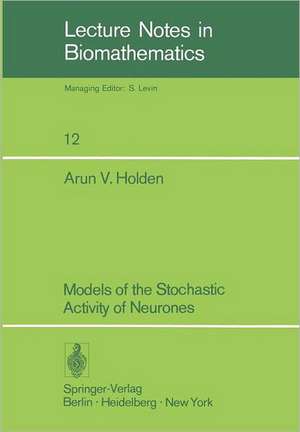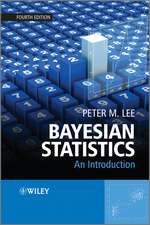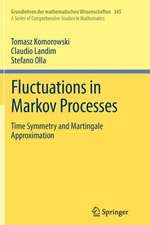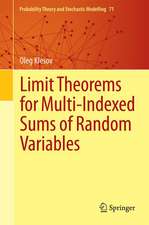Models of the Stochastic Activity of Neurones: Lecture Notes in Biomathematics, cartea 12
Autor A. V. Holdenen Limba Engleză Paperback – noi 1976
Din seria Lecture Notes in Biomathematics
-
 Preț: 378.54 lei
Preț: 378.54 lei -
 Preț: 380.45 lei
Preț: 380.45 lei -
 Preț: 413.37 lei
Preț: 413.37 lei -
 Preț: 390.63 lei
Preț: 390.63 lei -
 Preț: 387.38 lei
Preț: 387.38 lei -
 Preț: 385.08 lei
Preț: 385.08 lei - 5%
 Preț: 366.56 lei
Preț: 366.56 lei -
 Preț: 384.70 lei
Preț: 384.70 lei -
 Preț: 388.13 lei
Preț: 388.13 lei -
 Preț: 394.29 lei
Preț: 394.29 lei - 5%
 Preț: 389.93 lei
Preț: 389.93 lei - 5%
 Preț: 370.74 lei
Preț: 370.74 lei -
 Preț: 384.86 lei
Preț: 384.86 lei -
 Preț: 387.96 lei
Preț: 387.96 lei -
 Preț: 404.29 lei
Preț: 404.29 lei -
 Preț: 391.61 lei
Preț: 391.61 lei -
 Preț: 384.48 lei
Preț: 384.48 lei -
 Preț: 384.48 lei
Preț: 384.48 lei -
 Preț: 383.71 lei
Preț: 383.71 lei -
 Preț: 379.68 lei
Preț: 379.68 lei -
 Preț: 384.09 lei
Preț: 384.09 lei -
 Preț: 405.66 lei
Preț: 405.66 lei -
 Preț: 379.48 lei
Preț: 379.48 lei -
 Preț: 400.65 lei
Preț: 400.65 lei -
 Preț: 385.25 lei
Preț: 385.25 lei -
 Preț: 390.25 lei
Preț: 390.25 lei -
 Preț: 395.47 lei
Preț: 395.47 lei -
 Preț: 378.71 lei
Preț: 378.71 lei -
 Preț: 382.95 lei
Preț: 382.95 lei - 15%
 Preț: 578.01 lei
Preț: 578.01 lei -
 Preț: 380.84 lei
Preț: 380.84 lei -
 Preț: 405.66 lei
Preț: 405.66 lei -
 Preț: 399.12 lei
Preț: 399.12 lei -
 Preț: 410.66 lei
Preț: 410.66 lei -
 Preț: 385.62 lei
Preț: 385.62 lei - 5%
 Preț: 371.10 lei
Preț: 371.10 lei -
 Preț: 378.71 lei
Preț: 378.71 lei -
 Preț: 386.99 lei
Preț: 386.99 lei -
 Preț: 401.61 lei
Preț: 401.61 lei -
 Preț: 350.30 lei
Preț: 350.30 lei -
 Preț: 383.33 lei
Preț: 383.33 lei -
 Preț: 408.54 lei
Preț: 408.54 lei -
 Preț: 398.53 lei
Preț: 398.53 lei -
 Preț: 399.67 lei
Preț: 399.67 lei -
 Preț: 391.79 lei
Preț: 391.79 lei -
 Preț: 384.86 lei
Preț: 384.86 lei -
 Preț: 401.61 lei
Preț: 401.61 lei -
 Preț: 392.60 lei
Preț: 392.60 lei -
 Preț: 406.05 lei
Preț: 406.05 lei
Preț: 396.24 lei
Nou
Puncte Express: 594
Preț estimativ în valută:
75.82€ • 81.08$ • 63.22£
75.82€ • 81.08$ • 63.22£
Carte tipărită la comandă
Livrare economică 18 aprilie-02 mai
Preluare comenzi: 021 569.72.76
Specificații
ISBN-13: 9783540079835
ISBN-10: 3540079831
Pagini: 380
Ilustrații: VIII, 370 p.
Dimensiuni: 170 x 244 x 20 mm
Greutate: 0.61 kg
Editura: Springer Berlin, Heidelberg
Colecția Springer
Seria Lecture Notes in Biomathematics
Locul publicării:Berlin, Heidelberg, Germany
ISBN-10: 3540079831
Pagini: 380
Ilustrații: VIII, 370 p.
Dimensiuni: 170 x 244 x 20 mm
Greutate: 0.61 kg
Editura: Springer Berlin, Heidelberg
Colecția Springer
Seria Lecture Notes in Biomathematics
Locul publicării:Berlin, Heidelberg, Germany
Public țintă
ResearchCuprins
1. Stochastic fluctuations in membrane potential.- 1.1 Thermal or Johnson-Nyquist Noise.- 1.2 Shot Noise.- 1.3 Flicker Noise.- 1.4 Conductance fluctuations.- 1.5 References.- 2. Quantal Fluctuations in Generator Potential.- 2.1 Psychophysical Evidence for Quantal Sensitivity in Vision.- 2.2 Some Neural Machines.- 2.3 Fluctuations in the Limulus Eccentric Cell Generator Potential.- 2.4 References.- 3. Models of Action Potential Initiation.- 3.1 The Logical Neurone.- 3.2 The Perfect Integrator Model.- 3.3 The Leaky Integrator Model.- 3.4 Two-Time Constant Models.- 3.5 The Hodgkin-Huxley Equations.- 3.6 Reduced Hodgkin-Huxley Equations.- 3.7 References.- 4. Fluctuations in Excitability.- 4.1 Single Time Constant Models with Fluctuating Threshold.- 4.2 Two-Time Constant Models with Fluctuating Threshold.- 4.3 Fluctuations in Hodgkin-Huxley variables.- 4.4 Models with Time-varying Threshold.- 4.5 References.- 5. Statistical Properties of a Spike Train.- 5.1 Stationarity.- 5.2 Interval Densities and Distributions.- 5.3 Spectral Densities of Point Processes.- 5.4 Input-Output Relations.- 5.5 References.- 6. Random Walk Models.- 6.1 The Random Walk Model.- 6.2 The Probability of First Passage.- 6.3 The Interval Probability Density.- 6.4 A Diffusion Approximation.- 6.5 Introduction of a Reflecting Barrier.- 6.6 Generalization of the Random Walk as a Birth and Death Process.- 6.7 Birth and Death Process Model of the Leaky Integrator.- 6.8 More Complex Random Walks.- 6.9 Some Comments on the Random Walk Models.- 6.10 References.- 7. Diffusion Models.- 7.1 The Input Process.- 7.2 The Wiener Process.- 7.3 The Ornstein-Uhlenbeck Process.- 7.4 The Diffusion Equations.- 7.5 The First Passage Time Distribution.- 7.6 The SIPIT Model.- 7.7 The SILIT Model.- 7.8 The Inverse Approach to Diffusion Models.- 7.9 References.- 8. Superposition Models.- 8.1 Some General Properties of Superposed Processes.- 8.2 Superposition of Regular Generator Trains.- 8.4 Some Applications of Superposition Theory.- 8.5 References.- 9. Collision Models.- 9.1 The Mechanism of Collision.- 9.2 The Geometry of Collision.- 9.3 Mutual Interaction Between Two Non-adjacent Generator Sites.- 9.4 The Biology of Collision.- 9.5 References.- 10. Gating and Selective Interaction Models.- 10.1 Compound Exponential Distributions and Gating Models.- 10.2 Selective Interaction Models.- 10.3 Models with Sub-threshold Interactions.- 10.4 Neural Micro-nets with Reciprocal Inhibition.- 10.5 References.- 11. Models of Synaptic Transmission.- 11.1 The neuro-muscular junction.- 11.2 Spontaneous miniature end-plate potentials.- 11.3 Presynaptic depolarization enhanced release.- 11.4 Models of facilitation and depression.- 11.5 Transmitter induced fluctuations in conductance.- 11.6 Dynamics of signal transfer across a synapse.- 11.7 References.- 12. Models of the stochastic activity of neural aggregates.- 12.1 Nets of logical neurones.- 12.2 Networks continuous in time and space: a field approach.- 12.3 Temporal behaviour of nets of excitatory and inhibitory neurones.- 12.4 Spatially distributed excitatory and inhibitory subpopulations.- 12.5 Some qualitative speculations.- 12.6 References.- 13. Information transmission by model neurones.- 13.1 The axon as a channel.- 13.2 Information preservation in a neural chain.- 13.3 Signal detection.- 13.4 Tranmission of steady signals using a rate code.- 13.5 Information transmission of periodic signals.- 13.6 Transmission of stochastic, time-varying signals.- 13.7 Transinformations of different codes.- 13.8 References.














